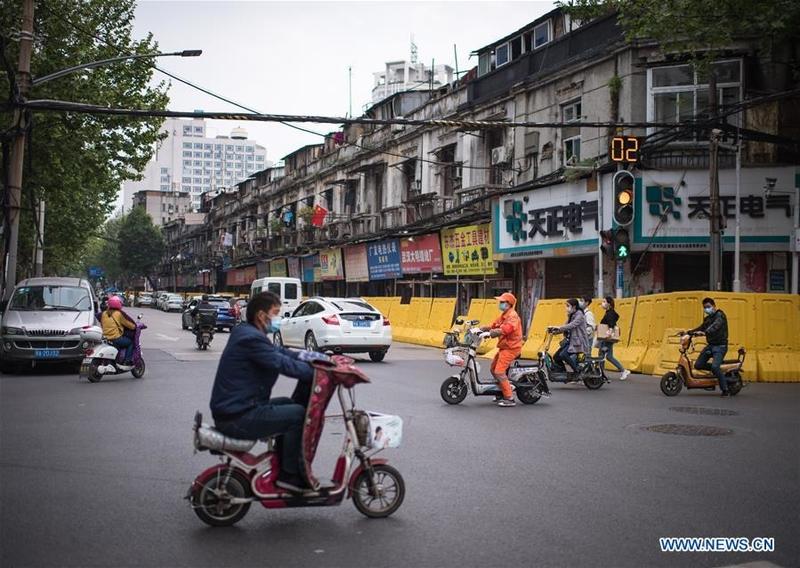 People travel outside in Wuhan, capital of central China's Hubei province, April 16, 2020. (PHOTO / XINHUA)
People travel outside in Wuhan, capital of central China's Hubei province, April 16, 2020. (PHOTO / XINHUA)
WUHAN – Once the hardest-hit city by novel coronavirus disease (COVID-19), Wuhan has been classified as a low-risk area of the outbreak as the city has met the criteria of no newly confirmed cases for the last 14 days, according to the latest assessment released Saturday by local authorities.
By the end of Friday, the central province of Hubei, which administers Wuhan, has 76 low-risk cities and counties and none with high risk or medium risk, according to the provincial COVID-19 epidemic prevention and control headquarters Saturday.
Wuhan, the provincial capital, saw its last medium-risk district of Qiaokou classified as low-risk compared with the assessment Thursday. It had its coronavirus risk evaluation downgraded from high-risk to medium-risk on March 27.
READ MORE: Wuhan reopens after 76-day lockdown
On Friday, Hubei reported no newly confirmed COVID-19 cases and 33 asymptomatic cases.
A series of decisive measures taken by the Chinese government over the last two months helped Wuhan achieve a high cure rate and a low mortality rate
Jiao Yahui, National Health Commission
According to the risk criteria defined in a guideline issued by China's State Council, cities, counties, and districts with no newly confirmed cases in the last 14 days are categorized as low-risk areas, those with fewer than 50 cases or those with over 50 but without a concentrated outbreak are classified as mid-risk areas, and those with over 50 cases as well as a concentrated outbreak are classified as high-risk areas.
A series of decisive measures taken by the Chinese government over the last two months helped Wuhan achieve a high cure rate and a low mortality rate, according to an official with the National Health Commission.
Jiao Yahui, an official with the National Health Commission, said the measures included applying quarantine policy, dispatching medical workers to Hubei, building makeshift hospitals, treating patients in severe condition with the country's best resources and making full use of traditional Chinese medicine (TCM).
ALSO READ: Outbound traffic resumes in Wuhan
According to Jiao, the novel coronavirus is highly contagious with concealed pathogenesis and atypical symptoms, making it hard to identify the source of infection.
Facing the huge challenge of the strained medical resources, more than 42,000 medics were assembled, and 16 temporary hospitals were converted from gymnasiums and convention centers in Wuhan.
During the peak period of the epidemic, Wuhan has a total of 60,000 hospital beds to meet the surging demand for medical resources.
"This is one of the reasons that we have a rather high patient cure rate and a low mortality rate," Jiao said.
 A woman exercises outside in Wuhan, capital of Central China's Hubei province, April 16, 2020. As the coronavirus epidemic wanes, life returns to normal in Wuhan gradually. (PHOTO / XINHUA)
A woman exercises outside in Wuhan, capital of Central China's Hubei province, April 16, 2020. As the coronavirus epidemic wanes, life returns to normal in Wuhan gradually. (PHOTO / XINHUA)
"Mortality rate is highly related to the treatment of intensive care patients," Jiao said, noting that authorities have used the best resources in the country to reduce the fatality rate.
READ MORE: Military medics sent to Wuhan to fight epidemic return home
Jiao pointed out that another highlight of China's COVID-19 treatment is the prompt intervention of the TCM in the whole process of treatment, which has been proved especially effective in alleviating early symptoms and shortening the time that patients needed to be tested negative.
Timely control and quarantine measures – the shutdown of outbound channels in Wuhan and Hubei after the outbreak, along with the allocation and transfer of funds, pooling resources from other parts of the country to guarantee the normal lives of local residents – also played a positive role in curbing the spread of the virus," Jiao added.


